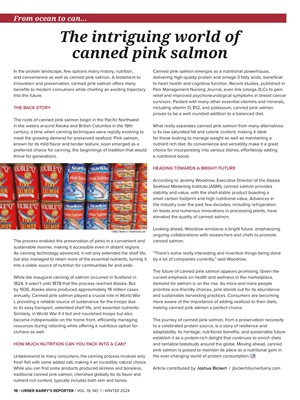
18 • URNER BARRY'S REPORTER / VOL. 19, NO. 1 / WINTER 2024
In the protein landscape, few options marry history, nutrition,
and convenience as well as canned pink salmon. A testament to
innovation and preservation, canned pink salmon offers many
benefits to modern consumers while charting an exciting trajectory
into the future.
THE BACK STORY
The roots of canned pink salmon begin in the Pacific Northwest
in the waters around Alaska and British Columbia in the 19th
century; a time when canning techniques were rapidly evolving to
meet the growing demand for preserved seafood. Pink salmon,
known for its mild flavor and tender texture, soon emerged as a
preferred choice for canning; the beginnings of tradition that would
thrive for generations.
The process enabled the preservation of pinks in a convenient and
sustainable manner, making it accessible even in distant regions.
As canning technology advanced, it not only extended the shelf life,
but also managed to retain more of the essential nutrients, turning it
into a viable source of nutrition for communities far and wide.
While the inaugural canning of salmon occurred in Scotland in
1824, it wasn't until 1878 that the process reached Alaska. But
by 1936, Alaska alone produced approximately 18 million cases
annually. Canned pink salmon played a crucial role in World War
I, providing a reliable source of sustenance for the troops due
to its easy transport, extended shelf life, and essential nutrients.
Similarly, in World War II it fed and nourished troops but also
became indispensable on the home front, efficiently managing
resources during rationing while offering a nutritious option for
civilians as well.
HOW MUCH NUTRITION CAN YOU PACK INTO A CAN?
Unbeknownst to many consumers, the canning process involves only
fresh fish with some added salt, making it an incredibly natural choice.
While you can find some products produced skinless and boneless,
traditional canned pink salmon, cherished globally for its flavor and
nutrient rich content, typically includes both skin and bones.
Canned pink salmon emerges as a nutritional powerhouse,
delivering high-quality protein and omega-3 fatty acids, beneficial
to heart health and cognitive function. Recent studies, published in
Pain Management Nursing Journal, even link omega-3LCs to pain
relief and improved psychoneurological symptoms in breast cancer
survivors. Packed with many other essential vitamins and minerals,
including vitamin D, B12, and potassium, canned pink salmon
proves to be a well rounded addition to a balanced diet.
What really separates canned pink salmon from many alternatives
is its low saturated fat and calorie content, making it ideal
for those looking to manage weight as well as maintaining a
nutrient rich diet. Its convenience and versatility make it a great
choice for incorporating into various dishes, effortlessly adding
a nutritional boost.
HEADING TOWARDS A BRIGHT FUTURE
According to Jeremy Woodrow, Executive Director of the Alaska
Seafood Marketing Institute (ASMI), canned salmon provides
stability and value, with the shelf-stable product boasting a
small carbon footprint and high nutritional value. Advances in
the industry over the past few decades, including refrigeration
on boats and numerous innovations in processing plants, have
elevated the quality of canned salmon.
Looking ahead, Woodrow envisions a bright future, emphasizing
ongoing collaborations with researchers and chefs to promote
canned salmon.
"There's some really interesting and inventive things being done
by a lot of companies currently," said Woodrow.
The future of canned pink salmon appears promising. Given the
current emphasis on health and wellness in the marketplace,
demand for salmon is on the rise. As more and more people
prioritize eco-friendly choices, pink stands out for its abundance
and sustainable harvesting practices. Consumers are becoming
more aware of the importance of adding seafood to their diets,
making canned pink salmon a perfect choice.
The journey of canned pink salmon, from a preservation necessity
to a celebrated protein source, is a story of resilience and
adaptability. Its heritage, nutritional benefits, and sustainable future
establish it as a protein-rich delight that continues to enrich diets
and tantalize tastebuds around the globe. Moving ahead, canned
pink salmon is poised to maintain its place as a nutritional gem in
the ever-changing world of protein consumption.
Article contributed by Joshua Bickert | jbickert@urnerbarry.com
The intriguing world of
canned pink salmon
From ocean to can...
©Billy F Blume Jr / Shutterstock.com